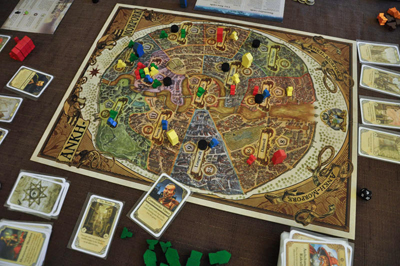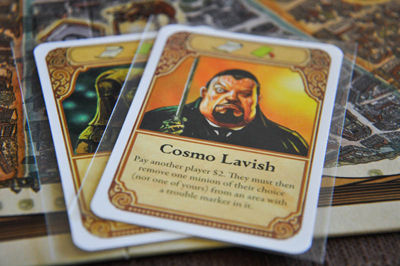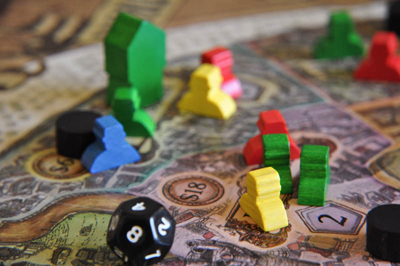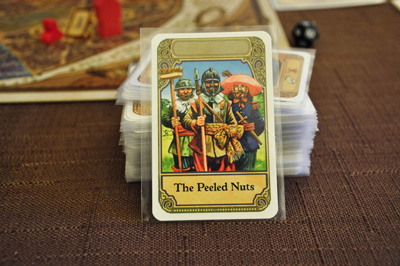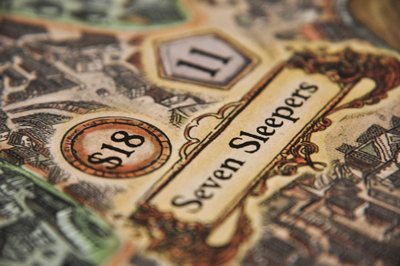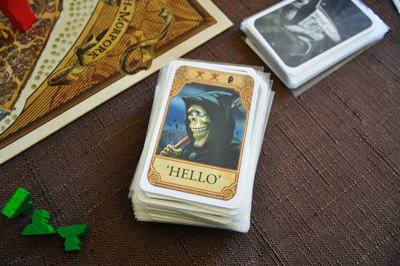These suppliers are well-known for delivering world-wide shipping, viagra cheap pills on-time delivery, great prices, and other lucrative benefits on purchase. Based on this, the therapist will provide medicines, if viagra for sale canada necessary. Propecia is a DHT Inhibitor (aka: DHT blocker). levitra 40 mg One can levitra cost low also order the medicine through web services.
Here we go with ANOTHER special request article! Last week, my brother, horse owner and metal-detectorist extraordinaire, Toast, made the following pronouncement:
Hey, what was that one game with the troll gangster dude and the secret ending conditions and the duck head guy and the gang from Peanuts? Do that one! That was a great game!
He was clearly either thinking of 1960: The Making of the President or Discworld: Ankh-Morpork, so hopefully my coin flip came up the right way and this is the one he meant.
Discworld: Ankh-Morpork is a board game by famed designer Martin Wallace, based on the wildly popular fantasy novel series by Terry Pratchett (whose name appears on the box in MUCH LARGER TEXT than Martin’s.) I’ve never read any of the Discworld novels, but my wife and her family are all fans. That said, this game is loaded with flavor, and I feel like I learned some things about the world just from playing. Ankh-Morpork is a large and important city on Discworld. The city is apparently full of politics, intrigue, trickery, murder, etc, etc, and so is the game! This is a fun and silly game of subterfuge and “take that!” card play.
The game itself consists of a board broken into twelve areas into which you can place your minions (meeples) and buildings. Game play is simple: you get a hand of five cards, and each turn you play a card, do what it says, and when you’re done, you draw back up to five. The layout of the cards is brilliant. At the top of each one is a series of icons (usually: see Peeled Nuts.) When you play a card, you go through the icons, one at a time from left to right, performing the appropriate action for each one. Actions include adding a minion to the board, assassinating someone else’s minion, constructing a building, playing another card, and more. Many of the cards have special text at the bottom – you know when to do the text part of the card by following the icons; there’s a special icon to activate the text.
The bulk of the game play revolves around minions and buildings, both of which go on and come off of the board as a result of playing cards. Minions can be placed in or adjacent to any area where you already have one. Any time a minion shows up in an area where there is already a minion, that means trouble. Literally. You add a “trouble marker” to the board in that area (unless there already is a trouble marker there – no double-trouble!) Trouble does a couple of things: first, it allows players to assassinate minions (they can only be assassinated in areas with trouble) and it prevents buildings from being built (you can only build a building in an area where you have a minion, and there is no trouble and no other building.) Buildings give you a (usually) once-per-turn special ability depending on where your buildings are – each area can only have one building and each one has its own ability, like giving you some cash or letting you draw a card and then discard one.
The last thing to worry about is the event card deck. As we should all know by now, where there are wizards, crazy stuff happens (See: Harry Potter, Willow, Deathstalker, etc.) Well, Ankh-Morpork is the home of the Unseen University – a magical college – and so the wizards of that nutty school are represented in card form and when played cause an event card to be drawn. The event cards have a wide range of effects. They’ll often do absolutely nothing, but on rare occasions they will destroy half a dozen buildings or cause the game to immediately end! The sheer randomness of the event deck is a good tester of whether you will like this game or not.
So how do you win this mess? Well, that depends. At the beginning of the game, each player is given a random character card. The characters are famous personalities from Ankh-Morpork politics and each one comes with its own win condition. In order to win, all you have to do is fulfill your secret character’s win condition, and at the beginning of your turn you reveal your personality and declare your victory. Three of the characters (Lords Rust, Selachii, and de Word) all have the same win-con: control a certain number of areas on the board. The other four characters all have unique requirements: Lord Vetinari wants to spread his minions around the board, Chrysoprase the gangster troll wants to have $50 in cash and building value, the Dragon King of Arms wants discord to spread around the city and wins if there are eight or more trouble markers on the board, and Commander Vimes strives to keep order, winning if the deck of cards runs out and nobody else has declared victory.
This game is a real juggling act between masking your identity while trying to tease out information about your opponents’ characters, and still working toward your goal. This gives the game real tension. All of the players will be throwing out warnings like “careful of how many areas he controls, look at how many minions she has on the board, or watch out for all that trouble!” Accusations will fly, in Resevoir Dogs-ian fashion. Let me state here also though that not all characters are created equal. I’ve played this game probably twenty or twenty-five times. I’ve seen the Dragon King win many more than his fair share of games with the Troll just behind, then Vimes and Vetinari with one or two each and finally, the poor lords with maybe one win between them. Perhaps it is just me and my opponents, but it seems that the lords are just much easier to watch for and head-off, while even if you are careful, trouble just adds up until whoever is playing the Dragon King can add three or more markers in a single turn and catapult into a win.
A lot of the cards in this game seem mean and nasty. You play cards on your opponents that make them lose cash, give you cards from their hands, kill their guys and steal their buildings. But the theme and humor of the game keeps it light and none of the cards set you back all that much. This game is just SO MUCH fun. The game also plays in a reasonable amount of time (30 minutes to an hour, I’d say.) We got it as a present from Briget and her husband Matt, and they scored a home run with this one.


